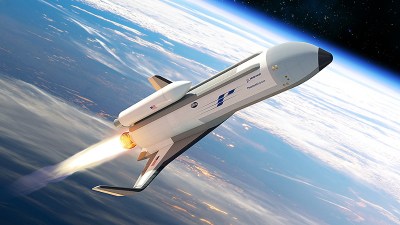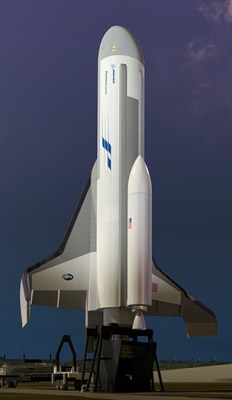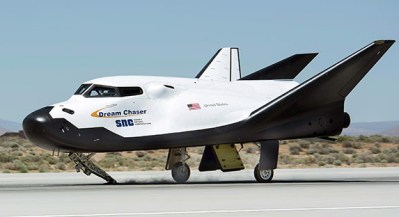Even for those of us who follow space news closely, there’s a lot to keep track of these days. Private companies are competing to develop new human-rated spacecraft and assembling satellite mega-constellations, while NASA is working towards a return the Moon and the first flight of the SLS. Between new announcements, updates to existing missions, and literal rocket launches, things are happening on a nearly daily basis. It’s fair to say we haven’t seen this level of activity since the Space Race of the 1960s.
With so much going on, it’s no surprise that not many people have heard of the XS-1 Phantom Express. A project by the United States Defense Advanced Research Projects Agency (DARPA), the XS-1 was designed to be a reusable launch system that could put small payloads into orbit on short notice. Once its mission was complete, the vehicle was to return to the launch site and be ready for re-flight in as a little as 24 hours.
 Alternately referred to as the “DARPA Experimental Spaceplane”, the vehicle was envisioned as being roughly the size of a business jet and capable of carrying a payload of up to 2,300 kilograms (5,000 pounds). It would take off vertically under rocket power and then glide back to Earth at the end of the mission to make a conventional runway landing. At $5 million per flight, its operating costs would be comparable with even the most aggressively priced commercial launch providers; but with the added bonus of not having to involve a third party in military and reconnaissance missions which would almost certainly be classified in nature.
Alternately referred to as the “DARPA Experimental Spaceplane”, the vehicle was envisioned as being roughly the size of a business jet and capable of carrying a payload of up to 2,300 kilograms (5,000 pounds). It would take off vertically under rocket power and then glide back to Earth at the end of the mission to make a conventional runway landing. At $5 million per flight, its operating costs would be comparable with even the most aggressively priced commercial launch providers; but with the added bonus of not having to involve a third party in military and reconnaissance missions which would almost certainly be classified in nature.
Or at least, that was the idea. Flight tests were originally scheduled to begin this year, but earlier this year prime contractor Boeing abruptly dropped out of the program. Despite six years in development and over $140 million in funding awarded by DARPA, it’s now all but certain that the XS-1 Phantom Express will never get off the ground. Which is a shame, as even in a market full of innovative launch vehicles, this unique spacecraft offered some compelling advantages.
A Scaled Down Shuttle
Launching like a rocket and landing like an airplane, one might assume the XS-1 Phantom Express to be something of a miniature Space Shuttle. Indeed there are similarities between the two craft, and there’s no question that lessons learned from the development, manufacture, and operation of the Shuttle fleet were taken into account. Realistically, if anyone is designing a spaceplane and doesn’t at least refer to the mountain of data NASA has accumulated on the subject, they’d be doing themselves an incredible disservice.
 But there are some fundamental differences between the two vehicles that make it difficult to compare them directly. For one, even conservative math would put the payload capacity of the Shuttle at least 12 times that of the XS-1. This naturally meant less thrust would be required to get the vehicle off the launch pad, so the XS-1 didn’t need an external propellant tank or strap-on boosters. The vehicle’s single Aerojet Rocketdyne AR-22 engine and all of the propellant required for the mission would be contained within the craft’s roughly cylindrical fuselage.
But there are some fundamental differences between the two vehicles that make it difficult to compare them directly. For one, even conservative math would put the payload capacity of the Shuttle at least 12 times that of the XS-1. This naturally meant less thrust would be required to get the vehicle off the launch pad, so the XS-1 didn’t need an external propellant tank or strap-on boosters. The vehicle’s single Aerojet Rocketdyne AR-22 engine and all of the propellant required for the mission would be contained within the craft’s roughly cylindrical fuselage.
That meant the XS-1 would land in the same condition it was in when it took off; an extremely important detail with regards to rapid reusability. On each Shuttle mission the external propellant tank would burn up in the upper atmosphere and the solid rocket boosters, while technically reusable, would need to be fished out of the ocean by a separate recovery team and go through a lengthy refurbishment process.
In comparison, the XS-1 would have only required a thorough inspection and refueling between missions. This level of aircraft-like reusability is the ultimate goal of several “New Space” companies such as SpaceX and Rocket Lab, as it promises to completely revolutionize how we utilize Earth orbit.
Even still, space is hard. While one could logically conclude that the cost and complexity of a space launch system has a fairly linear relationship with its payload capacity, even the smallest orbital rockets are technical marvels that navigate a razor-thin line between generating useful thrust and self-annihilation. Maintaining that delicate balance all the way to orbit is exceptionally difficult no matter how large or small the craft is. Which is exactly why the XS-1 was never designed to go that far.
Falling, With Style
While the XS-1 might have the outward appearance of the Space Shuttle Orbiter, in operation it would have been much closer to the first stage of a Falcon 9 rocket. It would accelerate the payload up to hypersonic speeds, ideally as high as Mach 10 according to a DARPA program overview, and carry it up to the edge of the Earth’s atmosphere. But it wouldn’t have had the energy to actually take the payload all the way to its final altitude, let alone enter orbit itself.
Once the XS-1 reached apogee, it would release a dorsal-mounted payload module. This module, itself essentially a small rocket, would continue the mission independently. Already traveling at high velocity through the thin upper atmosphere, it would be able to push the payload the rest of the way “up the hill” and into orbit with a comparatively low-thrust engine.

With its primary mission now complete, the XS-1 would begin falling back down to Earth on a sub-orbital trajectory. Reentering the atmosphere at relatively low velocity, only minimal shielding would have been necessary to survive aerodynamic heating. After being slowed to sub-sonic speeds by air resistance, the craft’s delta wing and over-sized control surfaces would give it the cross-range capability to glide back to the launch site.
Winged Victory
Even before they managed to send one of them into space, engineers were already trying to design a hybrid vehicle that would combine the power of a rocket with the more docile flight characteristics of an airplane. The Space Shuttle proved that the idea could work in the real-world, but so many concessions had to be made that it’s difficult to really call it a success. While a technical triumph in its own right, the winged Orbiter never delivered on its promise of cheap and rapid access to space. In fact, one could argue it did the exact opposite.

Today, SpaceX has shown that you don’t need wings to make a reusable rocket. While they’re still a long way off from daily flights, they’ve achieved a reflight cadence equal to that of the Space Shuttle program at a fraction of the cost. Even so, winged spacecraft have an undeniable appeal to engineers and futurists alike.
Companies like Virgin Galactic and Sierra Nevada are pushing ahead with their own versions of the concept, though of course its still far too early to say if they’ll be any more successful than the Shuttle was. In any event, while the XS-1 Phantom Express will likely go down as yet another in a long line of “paper rockets” that never left the drawing board, it’s safe to say that the dream of a practical spaceplane is alive and well.















We need some discussion of X-37B, obviously, since it seems to be the upper component of Phantom Express. And the Falcon 9 and X-37B combination fulfill the mission.
In a way the X-37B and the XS-1 are opposites. The XS-1 was supposed to take off on it’s own, and launch a rocket to put a satellite into orbit, but never orbits itself. The X-37B is launched on top of a rocket, and puts itself into orbit as a satellite. So, plane -> rocket vs rocket -> plane.
The way the X-37B is (reportedly) used, is basically as a reusable satellite-bus that can return to earth intact along with it’s (mostly secret) payload.
The X-37B still needs the Falcon 9 second stage. Space X’s Starship will reuse both stages with the second stage using wings for some fligIht but with a vertical landing. Truth is even the Falcon 9 uses wings to some degree with the grid fins.
” ideally as high as Mach 10 ”
Much better than SpaceX at mach 6 to save enough fuel for a powered return.
So this would have been like Arthur C Clarke’s vision of a launcher in “Prelude to Space”
Morty, there are an infinite number of space planes that never were.
So it may have been an attempt to revive the NASP X30 project from its roots, before the feature creep took over.
So they pocketed $140 million and delivered nothing. Great business model.
Sadly, that has been the Boeing business model for a while. Just look at the SLS and Constellation before it.
Where’s the Scott Manley video? I WANT TO HEAR THIS IN A SCOTTISH ACCENT!
Am I seeing this right? Does the Dream Chaser use a “nose skid”?
Yes. Tires don’t like being in vacuum. Neither do bearings. “The best part is no part.” The only real reason to have a nose wheel would be for steering. But the Dream Chaser will basically fly in a straight line down the middle of the runway, then stop. It’ll be towed off the runway. It’s not like a 737 taxiing to the gate.